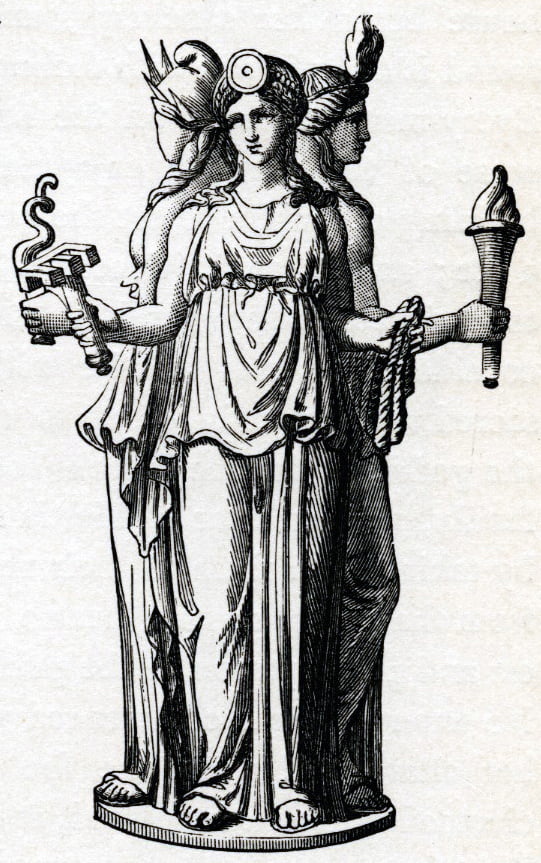Hecate, a multifaceted deity in ancient mythology, holds a significant position within the pantheon of gods and goddesses. Originating from Greek mythology, she is often depicted as a powerful figure associated with witchcraft, magic, and the night. Hecate’s origins trace back to the pre-Olympian era, where she was revered by early civilizations for her unique attributes and formidable influence.
Hecate’s role and symbolism extend beyond mere mythological tales. She is frequently portrayed as a goddess with the ability to traverse the realms of the heavens, earth, and underworld. This triple-domain influence underscores her versatility and the broad spectrum of her powers. Additionally, Hecate is often depicted holding torches, keys, or serpents, each symbolizing her dominion over light, knowledge, and transformation.
In ancient texts, Hecate’s significance is further emphasized through her associations with crossroads, thresholds, and liminal spaces. These intersections serve as metaphors for transitions and choices, highlighting her role as a guide and protector during pivotal moments. Her presence at these junctures reinforces her reputation as a deity who aids in navigating the complexities of life and the unknown.
The attributes of Hecate are both diverse and profound. As the protector of witchcraft and witches, she embodies the archetype of the wise and powerful sorceress. Her connection to the moon and the nocturnal world enhances her enigmatic aura, making her a central figure in various rituals and esoteric practices. Furthermore, her ability to invoke fear and awe underscores the duality of her nature, balancing benevolence and severity.
Overall, Hecate’s enduring legacy in mythology and her profound impact on cultural and spiritual practices highlight her importance as a deity. Her complex character, encompassing elements of protection, magic, and transformation, continues to captivate and inspire those who seek to understand her deeper mysteries.
Origins and Mythological Background
Hecate’s origins can be traced back to ancient Greek mythology, though some scholars suggest that her roots may extend even further, touching upon pre-Greek cultures. In Greek mythology, Hecate is a unique figure, often depicted as a powerful goddess associated with witchcraft, magic, and the night. The earliest references to Hecate appear in Hesiod’s “Theogony,” where she is portrayed as a mighty deity honored by Zeus himself. Hesiod’s account suggests that Hecate was an ancient and primordial goddess, holding sway over the earth, sea, and sky.
Her mythological background is rich and complex, intertwining with various aspects of ancient Greek religion and culture. Hecate was often depicted holding torches, symbolizing her role as a guide through the night and the darkness. This imagery connects her to the underworld and the dead, further solidifying her association with magic and the supernatural. In some myths, she is seen as a protector of crossroads and a guardian of boundaries, both physical and metaphysical. This duality reflects her multifaceted nature, embodying both benevolent and malevolent aspects.
While primarily known from Greek mythology, some theories suggest that Hecate’s origins may be linked to earlier Anatolian or Thracian deities. This connection is supported by the fact that Hecate was often worshipped in regions outside mainland Greece, particularly in Asia Minor. Her worship in these areas indicates a broader cultural significance, possibly hinting at a syncretic evolution of her character over time.
In the early narratives, Hecate was not exclusively linked to witchcraft and witches, but her association with these elements grew over time. As the goddess of magic and the night, she naturally became a patroness of witches and those who practiced the mystical arts. This evolution in her perception is a testament to the enduring and adaptable nature of her mythos, allowing her to remain a significant figure in both ancient and modern contexts.

Hecate’s Attributes and Symbols
Hecate, a multifaceted deity revered in ancient mythology, is often represented through a myriad of symbols and attributes that encapsulate her essence and divine role. One of the most prominent symbols associated with Hecate is the crossroads. Crossroads signify a place of transition and decision-making, embodying Hecate’s role as a guardian of paths and her ability to navigate between different realms. This association underscores her dominion over boundaries and thresholds, granting her the power to guide souls and influence fate.
Torchlight is another significant symbol linked to Hecate. Torches illuminate the darkness, symbolizing enlightenment, revelation, and protection. Hecate, often depicted holding a torch, is seen as a bearer of light who guides individuals through the shadows of uncertainty and fear. This attribute highlights her role as a protector and a bringer of wisdom, providing clarity in moments of doubt.
The presence of keys in Hecate’s iconography further cements her status as a guardian of thresholds. Keys represent the ability to unlock doors to new experiences and knowledge, aligning with Hecate’s power to access different realms and dimensions. As a custodian of secrets and mysteries, Hecate’s keys symbolize her control over hidden knowledge and the passage between worlds.
Dogs are also closely associated with Hecate. These loyal creatures are seen as her companions and guardians, reflecting her protective nature. In ancient depictions, dogs often accompany Hecate, symbolizing vigilance, loyalty, and the ability to traverse between the mundane and the supernatural. The presence of dogs underscores her role as a protector of those who practice witchcraft, ensuring their safety and guiding them on their spiritual journeys.
Through these symbols—crossroads, torches, keys, and dogs—Hecate’s identity as a powerful and protective goddess is vividly portrayed. Each attribute contributes to a deeper understanding of her multifaceted nature and her enduring significance in mythology and witchcraft.
Role as Protector of Witchcraft
Hecate, revered as the protector of witchcraft and witches, holds a significant place in the pantheon of deities associated with magic. Her influence permeates various magical practices, rituals, and spells, establishing her as a cornerstone in the tradition of witchcraft. Historically, Hecate was venerated as a goddess capable of wielding immense power over the natural and supernatural realms, which made her an essential figure for those seeking to harness mystical energies.
In ancient times, Hecate was often invoked during rites of protection and divination. Her association with crossroads, the boundary between worlds, and the night made her a guardian of those who practiced the esoteric arts. She was believed to grant her followers access to hidden knowledge and to offer protection against malevolent forces. This protective role extended to her ability to guide souls through the underworld, ensuring safe passage and shielding them from harm.
Modern-day practitioners of witchcraft and Wicca continue to invoke Hecate in their practices. Her presence is felt in rituals designed to protect individuals and spaces from negative energies. Many witches call upon Hecate to bless their altars, tools, and spells, seeking her guidance and safeguarding. Her symbols, such as the key, the torch, and the crossroads, are frequently incorporated into magical workings to invoke her protective essence.
Hecate’s role as a protector is not merely confined to defensive magic. She is also a guide for those delving into the deeper aspects of witchcraft, offering wisdom and insight. Her duality as both a guardian and a revealer of secrets makes her an invaluable ally for those exploring the mysteries of the craft. By invoking Hecate, practitioners aim to align themselves with her ancient wisdom and protective power, ensuring their magical practices are both safe and potent.

Hecate in Ancient Rituals and Worship
Hecate, often revered as the goddess of witchcraft, magic, and the crossroads, held a significant place in ancient rituals and worship practices. Her veneration dates back to early Greek and Roman societies, where she was seen as a powerful protector of witches and those who practiced the esoteric arts. Historical records and archaeological findings provide a glimpse into the kinds of rituals and ceremonies dedicated to Hecate.
In ancient Greece, Hecate was honored during the Deipnon, a monthly ritual that took place at the new moon. During this time, offerings known as “Hecate’s Supper” were left at crossroads, which were sacred to her. These offerings often included food, such as eggs, garlic, and fish, accompanied by incense and libations. The crossroads were symbolic, representing the transitions and choices Hecate was believed to oversee. Additionally, dogs, particularly black ones, were associated with Hecate and sometimes sacrificed in her honor.
Hecate’s worship was not limited to Greece; she was also venerated in Rome, where she was known as Trivia, goddess of the three-way crossroads. Here, the rituals were similar, with offerings left at crossroads and statues erected at these sites to mark her presence. The Romans also celebrated her during the festival of Lemuria, a time dedicated to appeasing the spirits of the dead, reflecting her role as a deity of the underworld.
Over time, the worship of Hecate evolved. By the Hellenistic period, her image had transformed from a singular deity into a triadic form, often depicted with three faces or bodies, symbolizing her dominion over the heavens, earth, and underworld. This triad representation further solidified her role as a guardian of boundaries and transitions. The rituals became more elaborate, with complex incantations and ceremonial magic being performed in her name.
Despite the shifts in religious practices over centuries, the essence of Hecate’s worship has persisted. Modern pagan and Wiccan traditions continue to honor her, drawing from ancient practices while adapting them to contemporary contexts. The legacy of Hecate as a protector of witchcraft and witches remains a testament to her enduring influence and the reverence she commands.
Hecate in Modern Witchcraft
In contemporary witchcraft and pagan practices, Hecate’s enduring legacy remains significant. Revered as a powerful protector and guide, her influence persists in various modern spiritual traditions. Modern witches honor Hecate through rituals, offerings, and invocations, often seeking her guidance in matters of magic, protection, and transformation.
One of the primary ways Hecate is venerated today is through the celebration of the new moon, known as the “Hecate’s Deipnon.” During this time, practitioners offer food, particularly eggs, garlic, and fish, at crossroads or altars dedicated to her. This ritual honors Hecate as the guardian of boundaries and thresholds, echoing her ancient role as a liminal deity.
Additionally, Hecate is often invoked in modern witchcraft for her association with witchcraft itself. Her attributes of wisdom, intuition, and the ability to navigate the unseen realms make her a revered figure among those who practice the craft. Modern witches may call upon her to aid in divination, spell-casting, and the development of psychic abilities.
Hecate’s ancient attributes have been adapted to fit contemporary spiritual practices in various ways. For example, her triple goddess form—representing maiden, mother, and crone—resonates deeply with modern practitioners who seek to honor the different phases of a woman’s life and the cyclical nature of existence. This adaptation highlights her role as a deity of transitions and personal growth.
Moreover, Hecate’s association with herbalism and medicinal plants remains relevant. Modern witches often incorporate her into their herbal practices, seeking her wisdom in the use of plants for healing and magical purposes. Her connection to the earth and natural cycles reinforces her role as a protector of nature and its mysteries.
Hecate’s presence in modern witchcraft underscores her timeless appeal and adaptability. As a protector of witchcraft and witches, she continues to inspire and guide those who seek her wisdom, ensuring her legacy endures in contemporary spiritual practices.
Hecate, the ancient Greek goddess of witchcraft, magic, and the night, has long been a figure of fascination in literature and popular culture. Her portrayal has evolved over centuries, reflecting changing societal attitudes and artistic trends. In classical literature, Hecate appears in works such as Hesiod’s “Theogony,” where she is depicted as a powerful and benevolent deity. However, her role in Euripides’ “Medea” and Shakespeare’s “Macbeth” casts her in a more sinister light, emphasizing her connection to witchcraft and the supernatural.
In art, Hecate has been represented in various forms, often depicted as a triple-faced goddess, symbolizing her dominion over the earth, sea, and sky. This iconography has persisted into modern interpretations, where she is frequently shown in triplicate or accompanied by dogs, her sacred animals. The Renaissance rekindled interest in classical mythology, and Hecate’s image appeared in numerous paintings and sculptures, emphasizing her mysterious and powerful nature.
Moving into contemporary times, Hecate’s presence in popular culture remains strong. She has been featured in numerous books, films, and television series. In Rick Riordan’s “Percy Jackson” series, Hecate is portrayed as an enigmatic and formidable goddess, guiding young demigods through their challenges. Similarly, in the television show “Charmed,” she is depicted as a guardian and mentor to modern witches, reinforcing her role as a protector of witchcraft.
Hecate’s influence extends to the world of gaming as well. In video games like “Hades” and “Smite,” she is a playable character, embodying her mythological attributes of magic and sorcery. These portrayals contribute to a broader understanding of Hecate, blending ancient mythology with modern storytelling techniques.
Overall, Hecate’s depiction in literature and popular culture highlights her enduring legacy. Whether as a benevolent guide or a formidable force, she continues to captivate the imagination, embodying the timeless allure of the mystical and the unknown.

The Empowering Dominion of Hecate
Hecate’s prominence in mythology and spiritual practices has traversed millennia, leaving an indelible mark on both ancient and modern traditions. As the revered goddess of witchcraft, magic, and the crossroads, her influence extends far beyond the confines of antiquity, deeply ingrained in the spiritual fabric of countless cultures. Her multifaceted role as a protector and guide through the unknown has cemented her status as a powerful symbol in the realm of the esoteric.
In ancient times, Hecate was venerated in mystery religions and public rituals alike. Her association with the moon, night, and the underworld made her a central figure in the spiritual lives of many. Temples and shrines dedicated to her were common, and she was invoked for protection, guidance, and the mastery of magical arts. Her role as a guardian at crossroads symbolized the pivotal moments in life’s journey, embodying the choice and transformation inherent in these transitions.
In contemporary spiritual practices, Hecate’s legacy continues to thrive. Modern neopagan and Wiccan traditions often revere her as a central deity, calling upon her for wisdom and protection. Her archetype as a wise crone and powerful sorceress resonates with those seeking to reclaim and celebrate feminine power and mysticism. Hecate’s enduring presence in popular culture, literature, and art further underscores her lasting relevance. She remains a potent symbol of the mystical and the unknown, offering a sense of continuity and connection to the ancient past.
Hecate’s role as a protector of witches and witchcraft remains a testament to her enduring influence. As spiritual landscapes continue to evolve, her presence will likely persist, adapting to new contexts while maintaining her core attributes. In the ever-changing tapestry of cultural and spiritual practices, Hecate stands as a timeless beacon, guiding and protecting those who seek her wisdom and embrace the mysteries she embodies.






